Rosy Boa enclosure guidelines are pretty simple. It all comes down to choosing the right type of setup, or modifying it to get the correct humidity (or lack thereof) …
Last updated on February 1st, 2023 at 09:31 am
Unless you’re lucky enough to live in the desert, your main concern when keeping Rosy Boas will be maintaining low humidity. The best way to do this is to choose an enclosure with adequate ventilation, and an appropriate substrate. Keep reading for guidelines on what enclosures work and how to furnish them.
Rosy Boa Enclosure setups
As with most snake enclosures, it doesn’t matter too much what material Rosy Boa setups are made of. What counts is that they are appropriately designed for your pet, or that you can modify them to get what you need.
Notwithstanding, it’s definitely easier to use a setup that already is configured correctly and ready to go. For Rosy Boas, this means a terrarium with a mesh top to allow for adequate ventilation. That’s why I usually recommend the Exo Terra Medium terrarium.
It has a nice mesh top, but also has a plastic border all around it so that your snake can’t rub its snout on mesh in the corners and hurt itself – this is very important!
With other setups, you’ll need to add mesh inserts for ventilation yourself, unless you can find versions with them pre-installed, as is the case with some (expensive) snake racks.
If you look at the list below, you’ll see that practically any enclosure type can work for Rosy Boas. Personally, I just recommend the Exo Terra terrariums because they are ready to go, and this makes things easier.
List of setups that can work:
- Tubs with mesh ventilation inserts
- Snake racks with mesh ventilation inserts
- PVC terrariums with adequate ventilation
- Wood terrariums/vivariums with adequate ventilation
- Tanks with mesh tops
- Plastic faunariums

Can you keep two rosy boas together?
As with most snake species, it’s a bad idea to keep two rosy boas together. They should kept separately unless breeding.
Keeping them separately gives them their own space, without competition for the warm spot or best hiding place. It also allows you to easily feed them individually.
Though Rosies aren’t cannabalistic like King Snakes and Milk Snakes, they have a strong feeding response. If you keep two together, and try to feed them together, then it’s only a matter of time before an accident happens.
Moreover, if one of the snakes gets sick, it will quickly give the illness to the other. If you keep them in different enclosures, on the other hand, transmission is less likely, and you can easily collect droppings for a fecal exam at the vets.
After all, with two snakes in one enclosure it’s pretty tough figuring out whose poop is whose. These are the kind of glamorous issues us reptile keepers have to bear in mind!
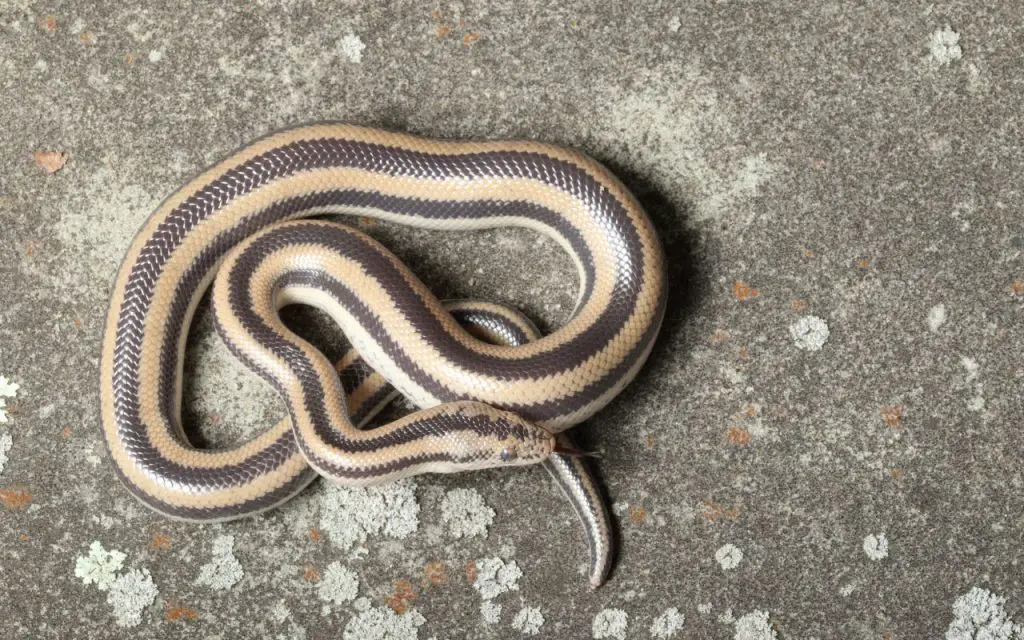
Do bioactive enclosures work for Rosy Boas?
If you read a lot of my care sheets, you’ll know I’m not a huge fan of bioactive enclosures for most snakes other than small species like the Rough Green Snake.
They’ve been extremely well marketed and gotten pretty trendy. The problem is that they are not hygienic, no matter how you try to tip-toe round the issue.
In fact, something I’ve noticed since the emergence of the bioactive trend is a resurgence in cases of scale rot amongst Ball Pythons housed in them. They just don’t work well for heavy-bodied snakes that make big messes.
That said, Rosy Boas are small enough that you would expect bioactive enclosures to work fine for them… The problem is that it’s hard making a bioactive desert setup and maintaining low humidity.
Deserts are dry – they aren’t a biotope that facilitates regular plant growth (other than cacti and thorn scrub).
If you try to add water on a regular basis so that your plants and springtails or isopods do well, you’ll end up making the enclosure too humid for your Rosy Boa.
All-in-all, it would be much easier to make a naturalistic but non-bioactive enclosure using rocks, dry leaves, caves, and branches. Get this right, and it will look just as good as a bioactive enclosure, with half the hassle.
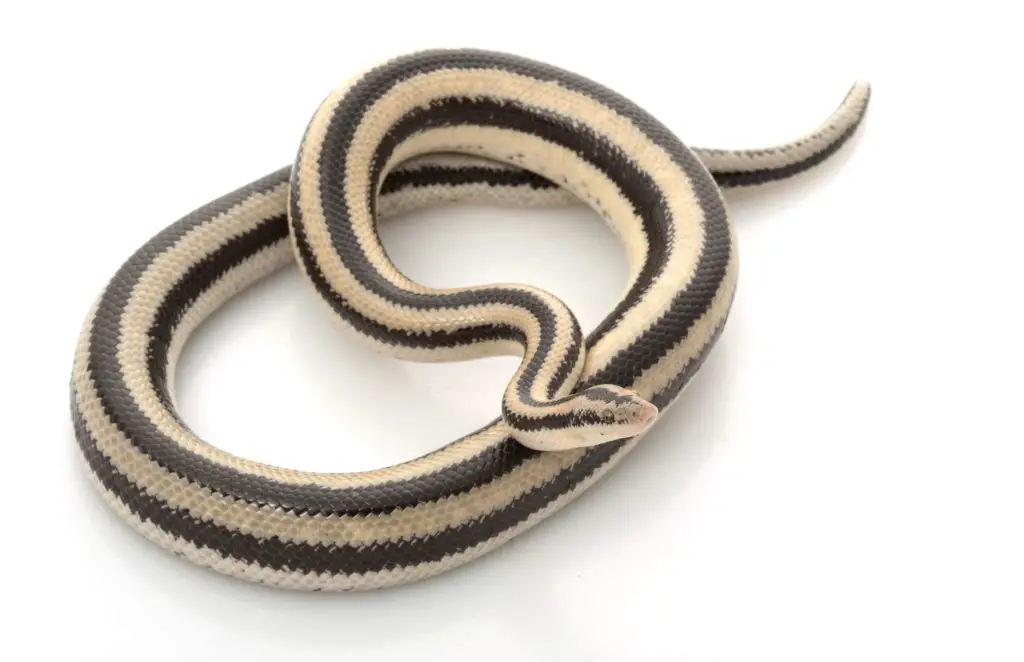
Rosy Boa Enclosure size guidelines
This is the main thing Rosy Boas have going for them when it comes to their setup: they almost never get over 36 inches (90cm) in length. In fact, their size is one of the main reasons Rosy Boas make good pets in general.
You can house most of them in a 24x18x18inches (60x45x45cm) enclosure their whole lives. Exceptionally large females that reach 36 inches (90cm) or more will still only need a 36-inch enclosure.
For their part, baby Rosy Boas are happy in a 10-12inches (25-30cm) long enclosure until they reach 18 inches (45cm) in length.
In fact, housing these snakes in enclosures that are too large can make them feel exposed, and places them under considerable stress.
| Age/size | Enclosure size |
| Juvenile up to 18 inches (45cm) | 10-12inches (25-30cm) long |
| Most adults | 24 inches (60cm) long |
| Females 36 (90cm) inches and larger | 36 inches (90cm) long |

Can a Rosy Boa live in a 10 gallon?
Something you might see discussed online is the “fact” that Rosy Boas can live in a 10 gallon tank. Well, the truth of the matter is that whilst they can live in a 10 gallon, it’s not great for them.
Your average 10 gallon long glass tank is about 20″ (50cm) long, which makes it just short of the ideal 24″ that I advise for adult Rosy Boas. It’s just a little too cramped, and for a very small step up in price you can house them in a 15 gallon.
Notwithstanding, you can use a 10 gallon tank for young adults, who are coming up to the 2 foot mark, then upgrade them to something large once they get over 24 inches in length.
How fast do rosy boas grow?
Growth rates vary hugely depending on a Rosy Boa’s sex, feeding regimen, and genetics. That said, they’re boas, and generally have the famous boa appetite, which leads to them growing very quickly compared to some other reptiles.
If fed consistently, your nightcrawler-sized baby Rosy should grow from 10-12 inches (25-30cm) to 18-30 inches (45-76cm) within 24 months. An increase in lenght of 80 – 200%! For females, this growth could continue slowly until the age of 36 months, with some eventually reaching 36 inches (90cm).
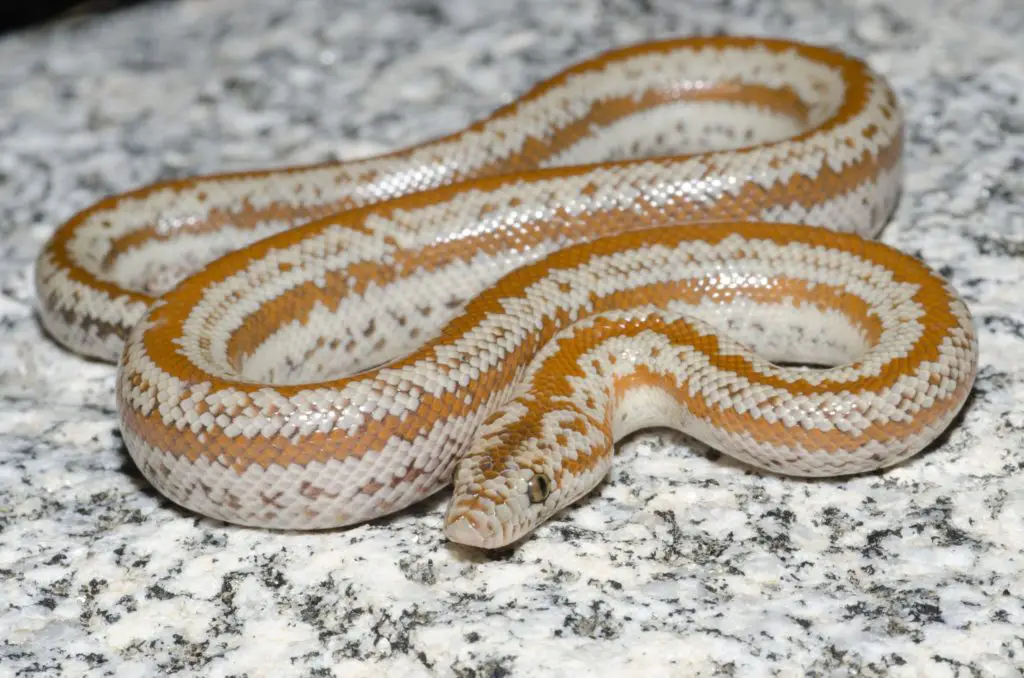
Humidity
The reason I keep repeating the importance of mesh tops and ventilation is simple: Rosy Boas will get sick if their enclosure is too humid.
Ambient humidity for these two species should be around 30 – 40%. You can raise this temporarily to 50 – 60% when they are shedding, but it should be lowered again quickly.
Mesh tops or vents are essential for maintaining this low humidity level unless you live in a desert zone. It’s also a good idea to invest in a humidity gauge, either digital or analogue.
Do rosy boas need a humid hide?
In my experience, Rosy Boas shed just fine without a humid hide. When their eyes go blue, give the enclosure a spray to get the humidity up to 50 – 60% and everything will be fine.
It’s pretty much standard practice to advise people to use humid hides all the time for all species (not sure why!), but I’m going to go ahead and say that I prefer to spray just before the animal sheds.
Trying to provide a humid hide full of sphagnum moss at all times just adds to the overall humidity of the enclosure, especially if some of that moisture ends up leaking into the surrounding subsrate. This isn’t ideal, and Rosies can quickly run into health issues if kept too humid.

Water features
No permanent water features should be present in your Rosy Boa’s enclosure. Instead, water should be given intermittently, just like in the desert.
Rosy Boas have the typical desert-species habit of drinking as much as they can in one go, which means they will sometimes drink loads the day after eating, then regurgitate all over the place. This something you definitely want to avoid…
Give it a few days before feeding or after feeding, every couple of weeks. Put it into the enclosure in a sturdy ceramic or resin bowl that your snake will be unable to tip over, then remove it after a day or so.
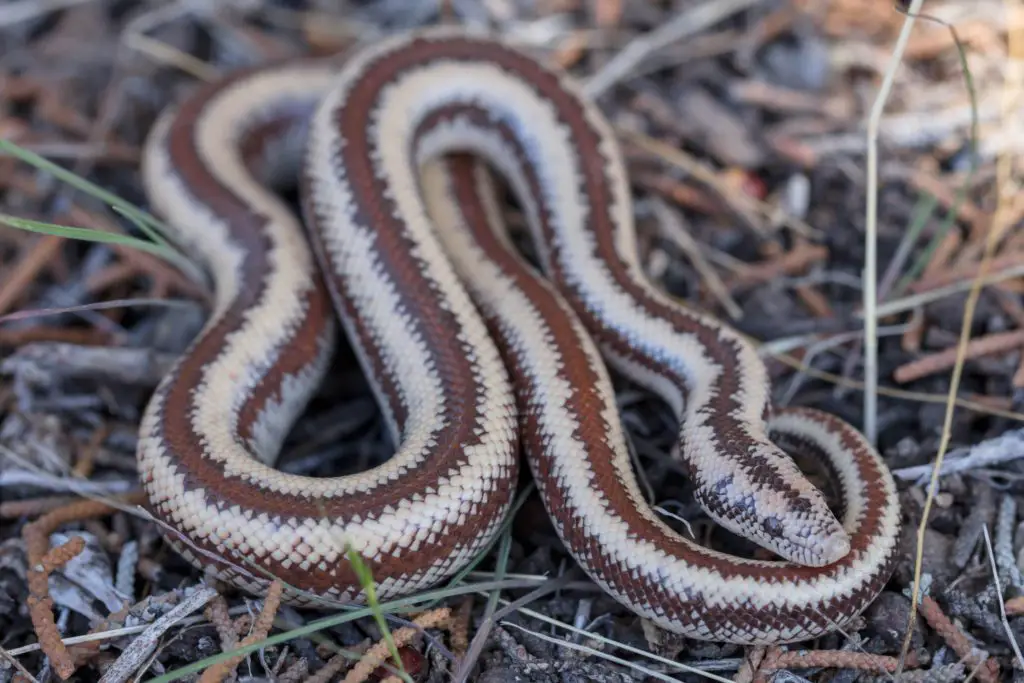
Do Rosy Boas need a basking light?
Like most other nocturnal rodent-eating snakes, Rosy Boas do not need UVB or UVA light to synthesize vitamin D3 and metabolise calcium.
You don’t have to provide them with any lighting, in fact, so long as there is ambient lighting in the room, and it’s on for 12 to 14 hours a day.
Nonetheless, you may want to use a light for them if you’ve gone to the trouble of making a naturalistic enclosure. After all, a light will add to the aesthetics, and make it into a true display setup.
You can use several types of light for this, including:
- LED strips
- UV lighting
- Heat lamps
- Mercury vapor bulbs (heat and UV)
If you do choose to use a heat lamp for light and heat, remember that you should still use a heat pad for nighttime heat, and that any heat source should always be used with a thermostat.

Best substrates for Rosy Boas
Small-chip aspen is quite possibly the best, and most popular, substrate for Rosy Boas (one brand name is Sani-Chips, for example). The reason for this is that it is cheap, keeps humidity low if well-ventilated, and allows your snake to burrow.
Other viable choices include paper fibre and even just newspaper, though these aren’t as nice to look at. If going for a naturalistic look, a topsoil and sand mix (70/30) apparently works well, though it wouldn’t be my first choice.
As always, avoid using cedar or pine, which are both toxic.
Do Rosy Boas burrow?
Rosy Boas have a triangular, shield-shaped rostral scale (nose scale). This is a typical anatomical sign of a reptile that likes to burrow, or at the least shove their nose into crevices to look for prey.
Overall, I’ve found that most Rosy Boas love to burrow whilst exploring or hunting for food. That said, some of them are happy just hiding in resin caves, pvc pipes, plastic hides, or even under flower pots.
They seem to be adaptable, and may vary in their preferences. My advice is to provid them with substrate that they can burrow in, but don’t worry if they don’t burrow either.
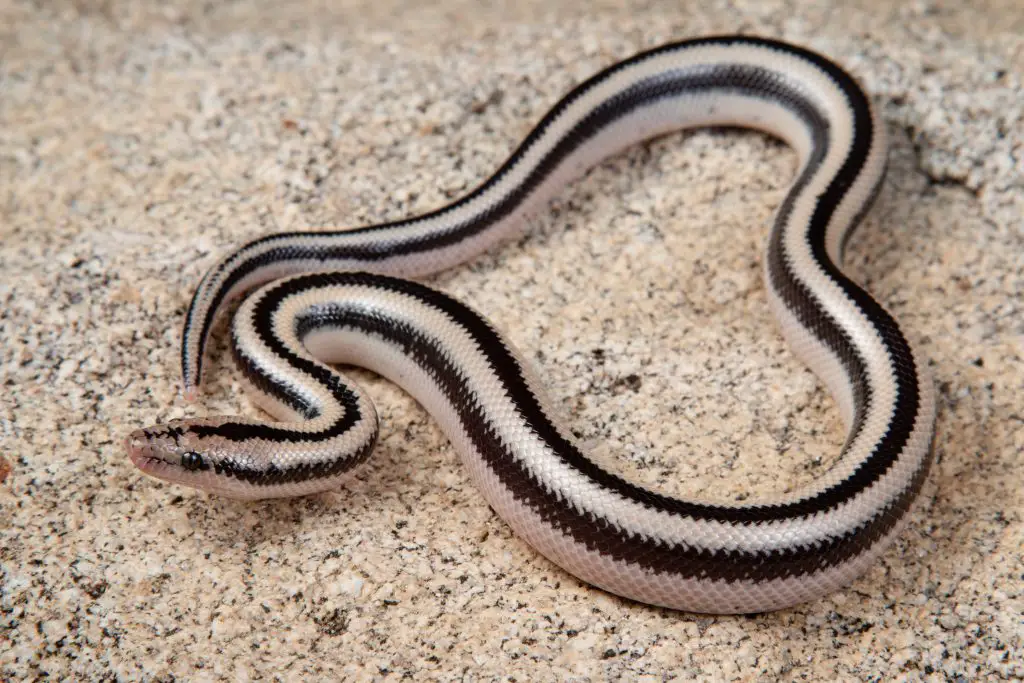
Hiding places
Hiding places are essential for these snakes. In the wild they either forage for prey by exploring rock crevices or ambush them by waiting at the entrance to a hideout.
Conversely, during the day they are very rarely active, preferring to spend their time hidden deep within a secure hiding place.
To the mind of a Rosy Boa, darkness = safety.
So, whatever type of enclosure you use, always make sure that at least two sturdy hiding places are available. My preference is for resin caves, like the Exo Terra caves.
You should place one on the warm side of the enclosure and another on the cool side, this way your snake can always hide and thermoregulate.
Note: You can read more about thermoregulation in my Rosy Boa Husbandry guide heating section.
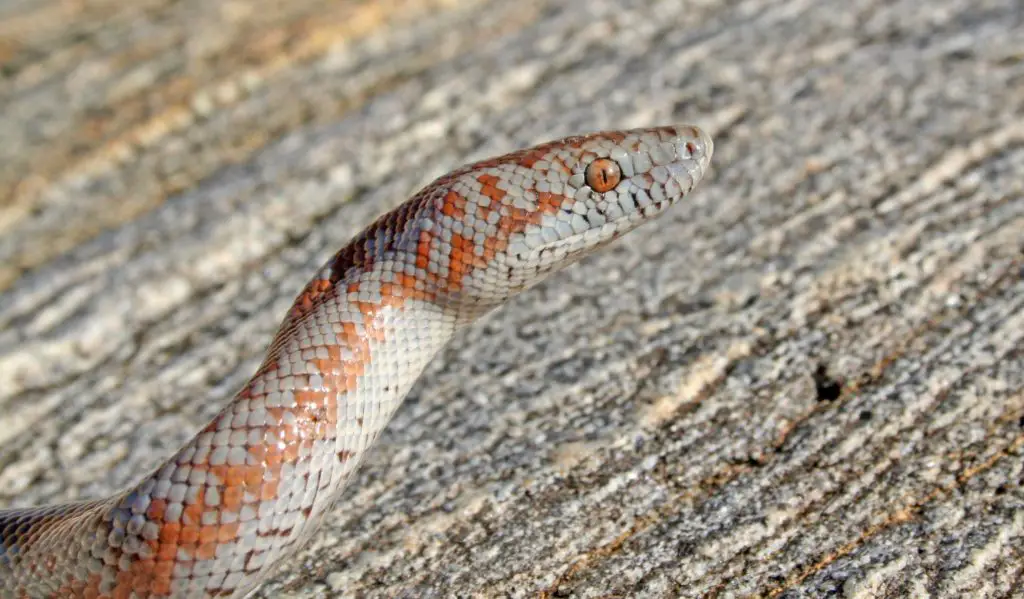
Do Rosy Boas Like to climb?
Much like baby Ball Pythons, Rosy Boas do climb. That said, they aren’t arboreal, and their climbing is generally limited to ascending low shrubs whilst hunting for nestling birds. This is part of their natural diet, so they do it more for necessity than fun.
Again, like Ball Pythons, they get slightly less coordinated as they get older, and eventually less inclined to climb altogether. In my opinion, it’s good to provide some branches, but only low ones to make a fall unlikely.
Are Rosy Boas semi arboreal?
Rosy Boas are certainly not semi-arboreal. They sometimes climb on low branches, just like any hungry reptile will when exploring. They have literally zero arboreality-related adaptations though, and are decidedly terrestrial.
When people tell you that a terrestrial snake like a Rosy Boa or a Ball Python is semi-terrestrial, it’s usually for one of two reasons. Either they have limited understanding of biomechanics and the role of an animal’s niche in evolutionary processes – or they want to sell you a larger enclosure for your pet.
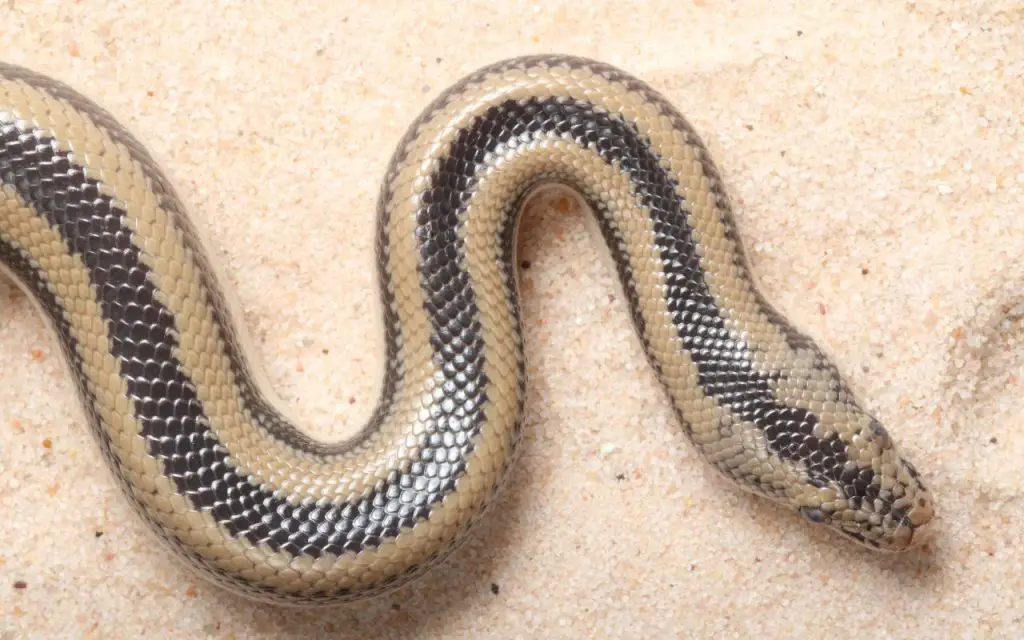
My choice for a Rosy Boa setup
My choice for a Rosy Boa setup is precisely the one shown in the video by Reptilemountain. TV., that you saw at the start of this article. This is the Exo-Terra Medium enclosure, which measures around 24 x 18 inches.
At this size, the enclosure is ideal for adult Rosy Boas, asides from exceptionally large females (which are also exceptionally rare!). I don’t do affiliate links, but you can follow this link to go directly to the Exo-Terra website, or find them on Amazon or eBay.
If you find the Exo-Terra range a little pricey, try to find a 15 gallon long glass tank, with a mesh top instead. Glass, mesh-topped tanks work great for animals that need low humidity. But always make sure that there is a plastic border around the edge of the top. This prevents the snake from rubbing its snout on the mesh.
Asides from glass tanks, you can also use any of the other setups I mention in this article, just make sure that your main priority is good ventilation and you can’t go wrong.

